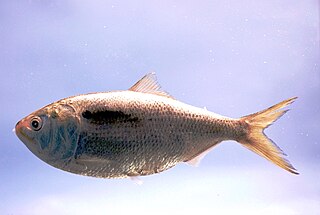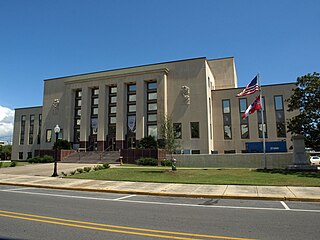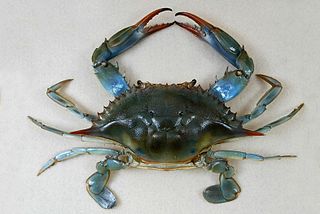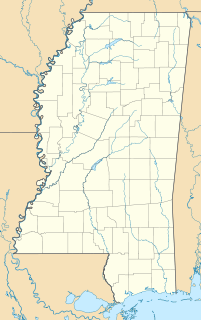
The Gulf Coast of the United States is the coastline along the Southern United States where they meet the Gulf of Mexico. The coastal states that have a shoreline on the Gulf of Mexico are Texas, Louisiana, Mississippi, Alabama, and Florida, and these are known as the Gulf States.

The Gulf of Oman or Sea of Oman is a gulf that connects the Arabian Sea with the Strait of Hormuz, which then runs to the Persian Gulf. It borders Iran and Pakistan on the north, Oman on the south, and the United Arab Emirates on the west And in some countries it is known as Makran Sea.

Menhaden, also known as mossbunker and bunker, are forage fish of the genera Brevoortia and Ethmidium, two genera of marine fish in the family Clupeidae. Menhaden is a blend of poghaden and an Algonquian word akin to Narragansett munnawhatteaûg, derived from munnohquohteau, referring to their use of the fish as fertilizer. It is generally thought that Pilgrims were advised by Tisquantum to plant menhaden with their crops.

Jackson County is a county located in the U.S. state of Mississippi. As of the 2010 census, the population was 139,668, making it the fifth-most populous county in Mississippi. Its county seat is Pascagoula. The county was named for Andrew Jackson, general in the United States Army and afterward President of the United States.

Biloxi is a city and one of two county seats of Harrison County, Mississippi, United States. The 2010 United States Census recorded the population as 44,054, and in 2019 the estimated population was 46,212. The area's first European settlers were French colonists.

The Pearl River is a river in the U.S. states of Mississippi and Louisiana. It forms in Neshoba County, Mississippi from the confluence of Nanih Waiya and Tallahaga creeks. and has a meander length of 444 miles (715 km). The lower part of the river forms part of the boundary between Mississippi and Louisiana. The river watershed contains large areas of bottomland hardwood swamp and cypress swamp, providing habitat for many species of wildlife, including sturgeon and black bears. As recently as 2008, endangered Ivory-billed woodpeckers were reportedly sighted here. The mouth of the river creates important marsh habitat along salinity gradients; these marshes have been the subject of many scientific studies. It is considered to be one of the most critical areas of natural habitat remaining in Louisiana.

Callinectes sapidus, the blue crab, Atlantic blue crab, or regionally as the Chesapeake blue crab, is a species of crab native to the waters of the western Atlantic Ocean and the Gulf of Mexico, and introduced internationally.

Dead zones are hypoxic (low-oxygen) areas in the world's oceans and large lakes, which causes these bodies of water to fail to support the aquatic life living there. Historically, many of these sites were naturally occurring. However, in the 1970s, oceanographers began noting increased instances and expanses of dead zones. These occur near inhabited coastlines, where aquatic life is most concentrated.

The National Marine Fisheries Service (NMFS), informally known as NOAA Fisheries, is the United States federal agency responsible for the stewardship of national marine resources. The agency conserves and manages fisheries to promote sustainability and prevent lost economic potential associated with overfishing, declining species, and degraded habitats.

The Mississippi River Delta is the confluence of the Mississippi River with the Gulf of Mexico in Louisiana, southeastern United States. The river delta is a three-million-acre area of land that stretches from Vermilion Bay on the west, to the Chandeleur Islands in the east, on Louisiana's southeastern coast. It is part of the Gulf of Mexico and the Louisiana coastal plain, one of the largest areas of coastal wetlands in the United States. The Mississippi River Delta is the 7th largest river delta on Earth (USGS) and is an important coastal region for the United States, containing more than 2.7 million acres of coastal wetlands and 37% of the estuarine marsh in the conterminous U.S. The coastal area is the nation's largest drainage basin and drains about 41% of the contiguous United States into the Gulf of Mexico at an average rate of 470,000 cubic feet per second.

Buccaneer State Park is a state park in the U.S. state of Mississippi. It is located off U.S. Highway 90 at Waveland. The park sits on the Gulf of Mexico and was entirely rebuilt after all its buildings were destroyed by Hurricane Katrina in 2005.

USNS Relentless (T-AGOS-18) was a Stalwart-class modified tactical auxiliary general ocean surveillance ship in service in the United States Navy from 1990 to 1993. Since 1998, she has been in commission in the National Oceanic and Atmospheric Administration (NOAA) fleet as the fisheries research ship NOAAS Gordon Gunter.

The eight U.S. regional fishery management councils are the primary forums for developing conservation and management measures for U.S. marine fisheries. The regional councils recommend management measures for fisheries in the Exclusive Economic Zone (EEZ); which are subject to approval and implemented by the National Marine Fisheries Service (NMFS). The councils were established by the Magnuson-Stevens Fishery Conservation and Management Act in 1976. In 1996, revisions to the laws governing the regional fishery management councils were made by the Sustainable Fisheries Act, which includes provisions to reduce bycatch, consider the effects of management decisions on communities, and protect essential fish habitats.
A fishery is an area with an associated fish or aquatic population which is harvested for its commercial value. Fisheries can be wild or farmed. Most of the world's wild fisheries are in the ocean. This article is an overview of ocean fisheries.

As with other countries, the 200 nautical miles (370 km) exclusive economic zone (EEZ) off the coast of the United States gives its fishing industry special fishing rights. It covers 11.4 million square kilometres, which is the second largest zone in the world, exceeding the land area of the United States.

The Gulf of Mexico is an ocean basin and a marginal sea of the Atlantic Ocean, largely surrounded by the North American continent. It is bounded on the northeast, north and northwest by the Gulf Coast of the United States; on the southwest and south by the Mexican states of Tamaulipas, Veracruz, Tabasco, Campeche, Yucatan, and Quintana Roo; and on the southeast by Cuba. The US states of Texas, Louisiana, Mississippi, Alabama, and Florida, which border the Gulf on the north, are often referred to as the "Third Coast" of the United States.

The Mississippi Department of Wildlife, Fisheries, and Parks (MDWFP), formerly known as the Mississippi Game & Fish Commission, is an agency of the government of the U.S. state of Mississippi responsible for programs protecting Mississippi fish and wildlife resources and their habitats, as well as administering all state parks; it has its headquarters in Jackson.

The Alabama shad is a species of clupeid fish endemic to the United States where it breeds in medium to large flowing rivers from the Mississippi River drainage to the Suwannee River, Florida, as well as some Gulf coast drainages. The biology and status of this fish is little known but it has become increasingly rare. The International Union for Conservation of Nature has rated it "data deficient" and the United States National Marine Fisheries Service has listed it as a Species of Concern. Reasons for its decline are thought mainly to be because of the many locks and dams blocking access for the fish to up-river spawning grounds.
Gordon Gunter was an American marine biologist and fisheries scientist. He is noted for his pioneering study of fisheries in the northern Gulf of Mexico, a topic to which he devoted his entire professional life over a career spanning 60 years. His own research, and that of the scientists under his direction, established an understanding of the ecology, comparative physiology of the plant and animal life, and commercial fisheries of the region, and he coined the phrase "fertile fisheries crescent" to refer to Mississippi Sound and adjacent waters along the United States Gulf Coast. He also pioneered the study of the comparative physiology of shellfish and fish.


















